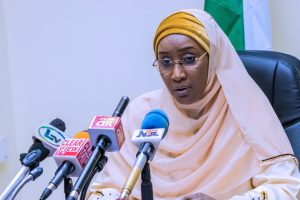
The Ministry of Humanitarian Affairs, Disaster Management, and Social Development has made a clarification on Cash Transfer Program.
The ministry made this known in a statement on Wednesday.
The attention of the National Cash Transfer Office (NCTO), under the Federal Ministry of Humanitarian Affairs, Disaster Management and Social Development has been drawn to a publication titled “Concerns Mount over Corruption and Inefficiency in Cash Transfer Programme” published on the front page of the This Day Newspaper of Sunday 24th January, 2021. This publication is not a true representation of the Household Uplifting Programme-Conditional Cash Transfer (HUP-CCT).
The National Cash Transfer Programme was introduced by the Federal Government in 2016 in partnership with the World Bank to fortify social safety nets and establish a social protection system in Nigeria. This is in line with the President Buhari led Government’s Social Investment agenda of eradicating poverty and promoting shared prosperity amongst the citizenry. It involves the release of a monthly stipend of N5,000 to the poorest and most vulnerable Nigerian households, mostly in rural communities.
The Programme has many objectives that include:
- Improved Household consumption that could improve the economy of the community
- Increase in utilization of health and nutrition services
- Improved school enrolment and attendance
- Improved environmental sanitation and management
- Improved Finance and Asset acquisition to ultimately enhance financial and economic inclusion
- Beneficiary engagement in sustainable livelihood
On the whole, the programme is a component of Government’s resolve to reduce community poverty in Nigeria
As at December 2020, the programme operated in 33 states of the country and the FCT. A total of 1,414,983 beneficiaries with 7,068,629 individual household member beneficiaries have been enrolled, covering 487 Local Government Areas, 4,716 Wards and 37,628 Communities. The programme targets to cover all States of the Federation by March 2021.
Contrary to claims of lacking implementation structure, the Programme has a clearly defined implementation structure with an electronic base beneficiary enrolment system that focuses on the Poor and Vulnerable Households (PVHHs) mined from the National Social Register. The PVHHs are identified through a combination of geographic and community based targeting mechanisms conducted by the various State Operating and Coordinating Units (SOCU) under the supervision and guidance of the National Social Safety Net Co-ordination Office (NASSCO). The Community Based Targeting (CBT) mechanism is used for the targeting process.
The following clarifications are necessary for the discerning public:
- The database of Poor and Vulnerable Households (PVHHs) is generated at the state level and domiciled at State Ministries of Planning. This information is accessible through the National Social Safety Net Project (NASSP) website-www.nassp.gov.ng
- All 3 grant based programmes are within budgetary provisions and are processed electronically.
- Rapid Transfer Register (RRR)- This is provided for under the Economic Sustainability Plan (ESP).
- Conditional Cash Transfer (CCT)- This is funded from the Abacha restituted funds and the World Bank facility.
- Cash Grant to Rural Women (CGRW)-This is a one-off cash grant and it is provided for in the 2020 Appropriation Act.
- Electronic disbursement is done to the extent of infrastructural capacity of any location, noting that the targeted beneficiaries of the CCT are the poorest of the poor who normally dwell in rural areas typically lacking banking and telecom facilities.
- At the commencement of the programme in September 2016, Memoranda of Understanding were signed between the FG and all states. Some states committed to the programme instantly while others joined in late. This clearly put some states in the lead ahead of others in the generation of the State Social Register of Poor and Vulnerable Households.
- The engagement of Payment Service Providers (PSPs) is carried out through a National Competitive Bidding (NCB) process that is within the World Bank Prior Review Mechanism threshold. Hence the transparency of the process is not in doubt.
- The CCT Programme provides capacity building, coaching and mentoring to beneficiaries on various topics including hygiene, girl child education, savings, etc. Formulation of co-operatives and savings are voluntary and managed by the beneficiaries with no degree of involvement by the Programme.
Currently, State Social Registers have been generated across all the states, while the CCT is being implemented in all 36 states with only Borno, Ebonyi and Ogun states yet to commence payments. While many goodwill and statements of gratitude have been received from many State Governments on the programme, success stories and testimonies abound on how the Programme is impacting the lives of the beneficiaries as well as poor and vulnerable Nigerians with a positive effect on their communities as well.
It is the desire of the Federal Ministry of humanitarian Affairs, Disaster Management and Social Development to ensure the full and successful implementation of the administration’s Social Investment Programmes, in full alignment to Mr. President’s deliberate policy of lifting 100 million Nigerians out of Poverty by year 2030.


